Commonly known as ‘The Clockwork Orange’, the Netherlands have become one of the most significant teams in World Cup history — and it’s not easy work to be considered that having never won the tournament, but their marvellous playing style and plethoric squads full of talent and technical qualities have made history throughout the years.
After the 2018 setback where they didn’t qualify, they’re now back in the world’s greatest football tournament, and this time with one of the biggest and most legendary managers of all time in their dugout: Louis van Gaal. The former Manchester United coach returned from retirement to get the ‘Oranje’ back to where they belong.
With a big squad full of exciting and interesting young names, mixing with experience and great technical qualities, the Netherlands have one of the best squads in the World Cup. So let’s take a look at how Van Gaal has brought joy back to his land.
This scout report in the form of a tactical analysis will provide a detailed insight into Netherland’s tactics under Louis Van Gaal. More specifically, this analysis aims to identify why and how Netherland come into this World Cup as one of probable shocks.
Predicted starting XI
The Netherlands have implemented a rotative, adaptable and mobile 3-4-1-2 with surprising names like Remko Pasveer who, with his excellent form and qualities on the ball, we think will be the starter in goal. Cody Gakpo and his magnificent start to the campaign has earned him a regular spot playing as a ‘10’ where he has developed even more his game.
Normally, the midfield could join the experienced Daley Blind and technical magician Frenkie de Jong, with some names trying to push their spots like Teun Koopmeiners or Marten de Roon; both are very versatile and dynamic.
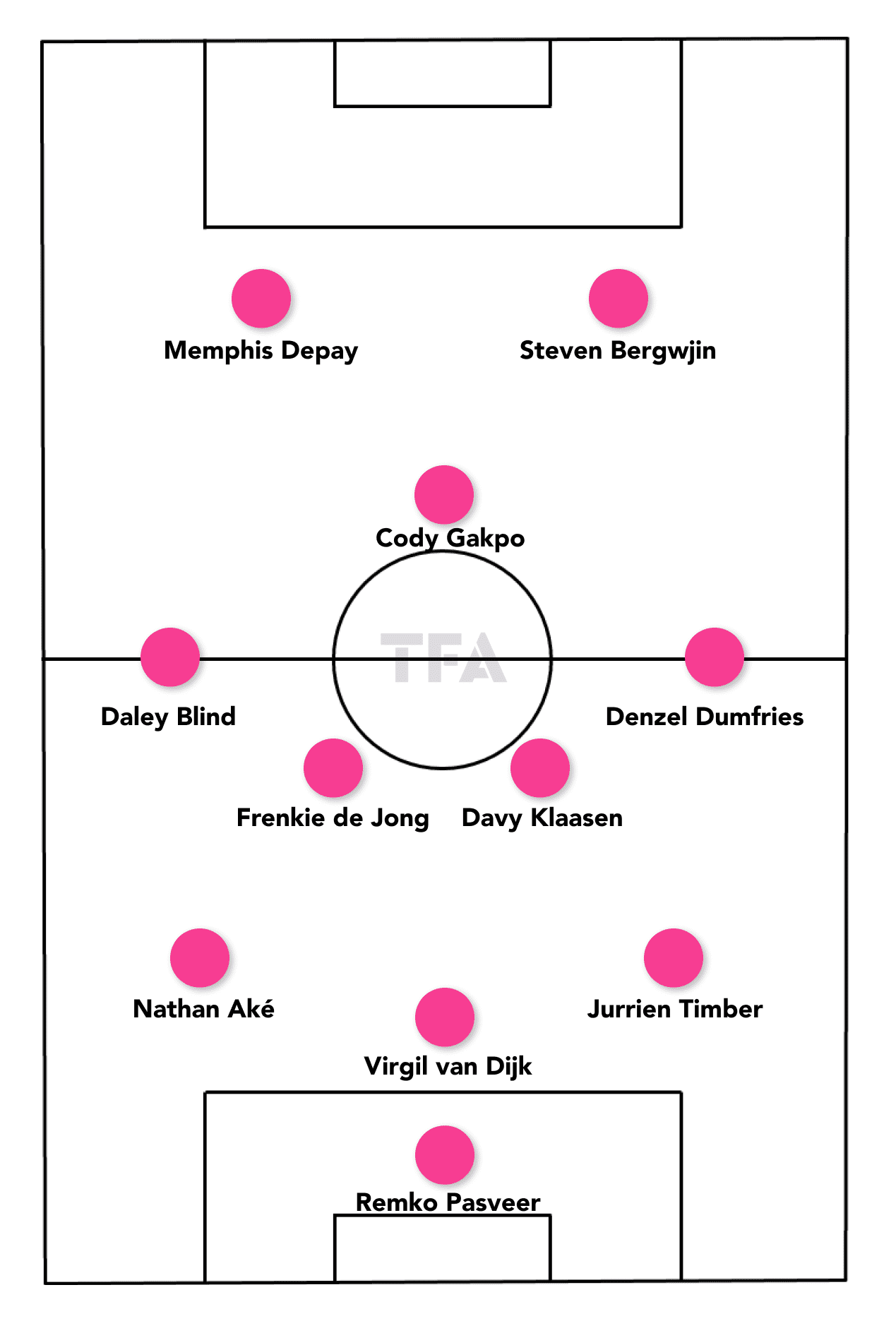
Louis Van Gaal has in his hands one of the most perfectly balanced squads of all the 2022 Qatar World Cup. Years pass and the Netherlands keep on producing interesting, versatile, technical and exciting talents that earn spots in the National Team squads as they’re also mentally capable of everything they want. Players at their peak combines very well with the ones in their last years, with surprising new names like Pasveer, or the elastic and stimulating Steven Berghuis that at his 30 he keeps living between the lines with sensitive and fine touches, to take an example.

Attacking phase
The ‘Oranje’ have displayed some very good-looking play in possession of late, as most of you would expect: The land of the original ‘Total Football’ should obviously play like this, and mostly under a possession-based lover such as Louis van Gaal.
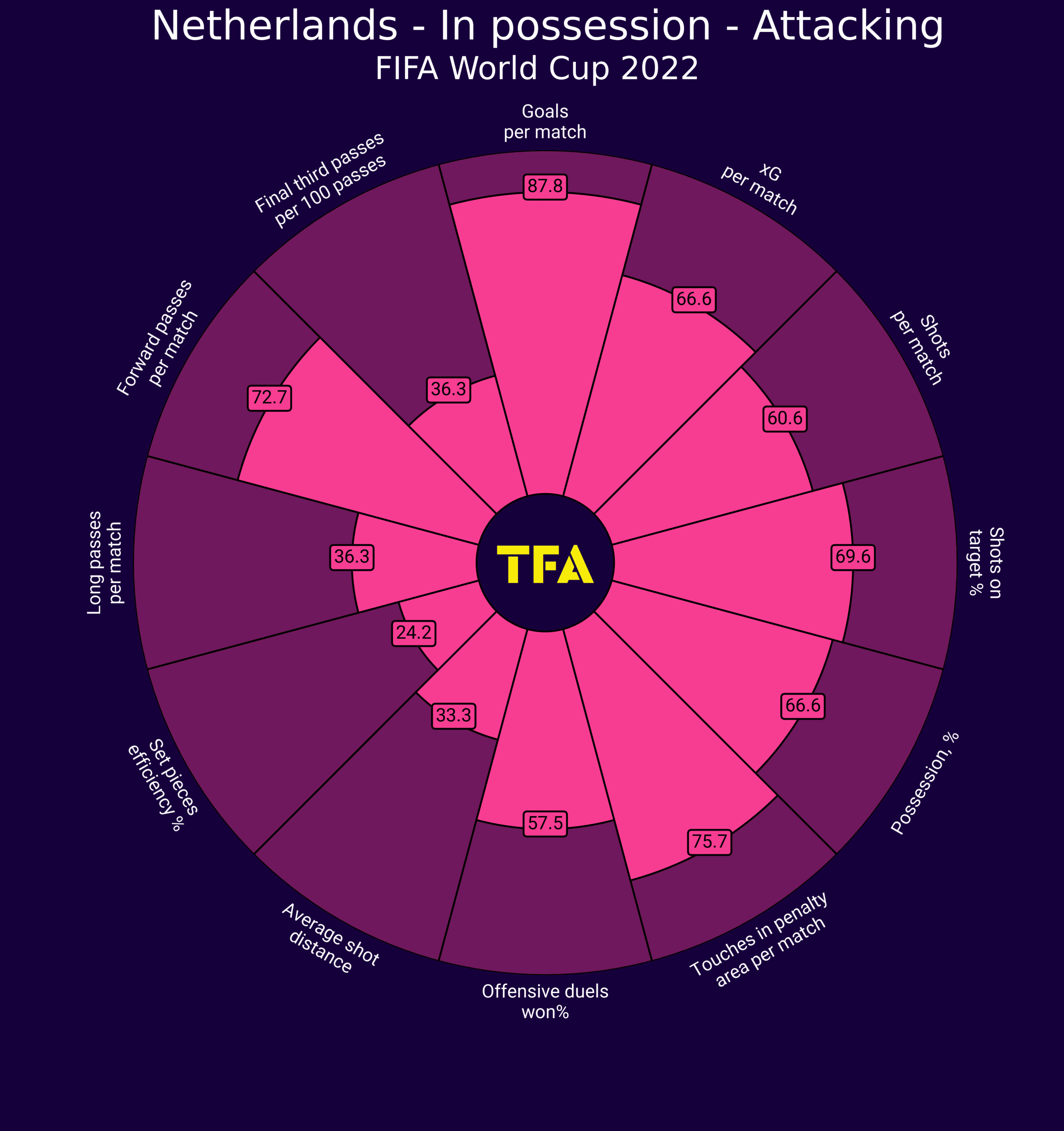
Playing with a high block and a back-three, when the Netherlands get the ball at their feet, rotations, mobility and dynamism power the engine.
The first automatism we get to see is one of the most known in their history: The rotations from a centre-back. In this case, Jurrien Timber is the one selected by Van Gaal to execute these complicated but vital off-the-ball movements.
Playing in a very similar system at Ajax, Timber knows exactly what kind of zones he has to step into: Frequently he sets up a back-four playing as a right-back to free Denzel Dumfries as a right-winger. But he’s also utilised as a midfielder, playing very inverted and with his back to goal, this to get another option behind the first line of pressure, to avoid dragging Gakpo or advanced players to deeper zones.
Here we can see a sequence that shows perfectly both things that we are explaining about Timber’s role in the build-ups: He firstly positioned himself as a right-back, went inside to form a double-pivot with de Roon, and then he makes a simple move going to the wide area to create a passing option for Virgil van Dijk and continue progressing.
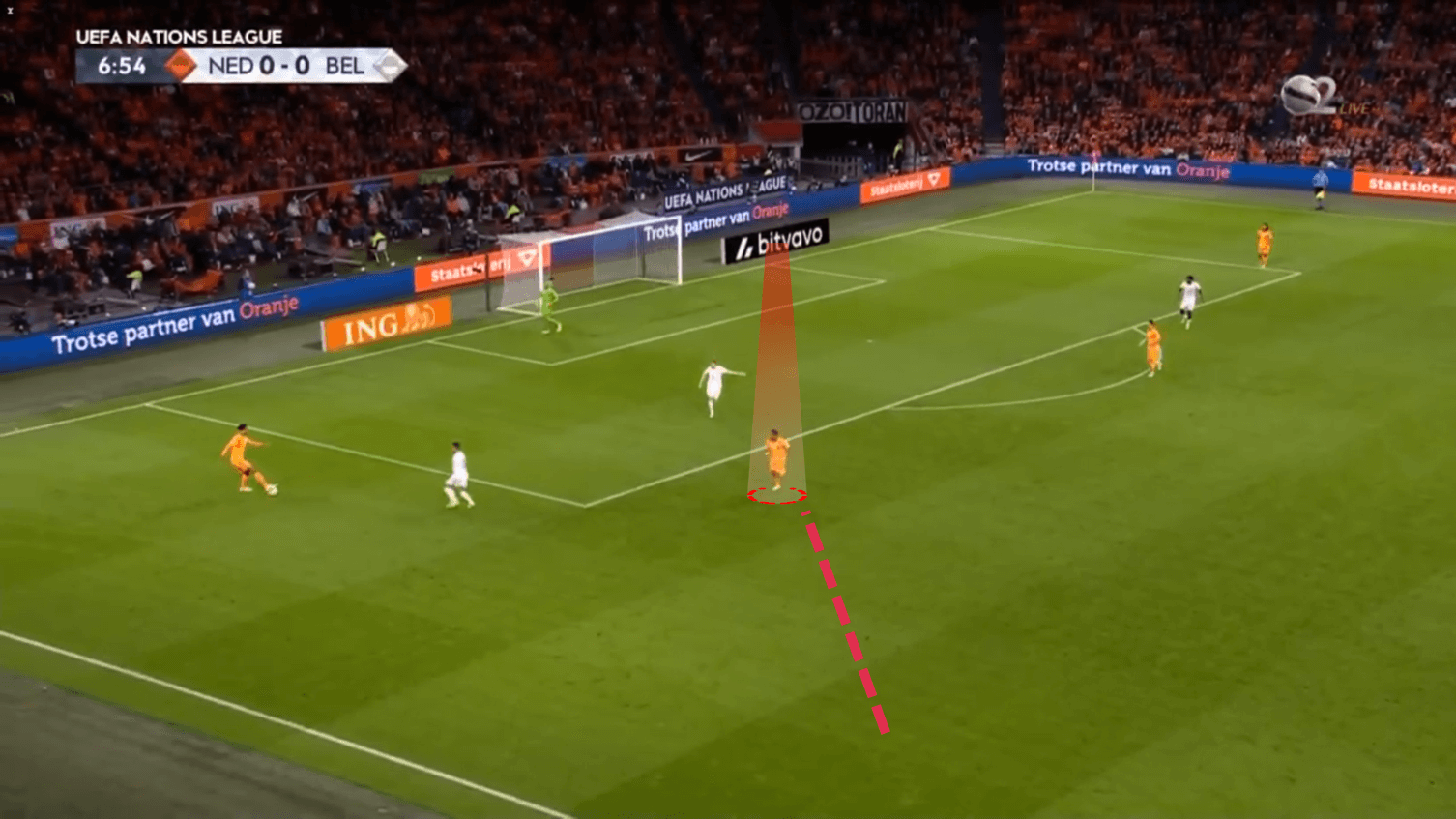
This creates confusion for the markers, as they do not know if they can go and press the ball carrier, or if they need to keep shadowing Timber but allow the Dutch centre-backs to carry the ball forward. That is another key in the Dutch game, if a centre-back sees a pocket of space, where they can drive forward and push the rival lines back to their own third, they’ll do it. Normally, it’s Nathan Aké who executes these situations, and he even joins as an overlapping centre-back in the final third.
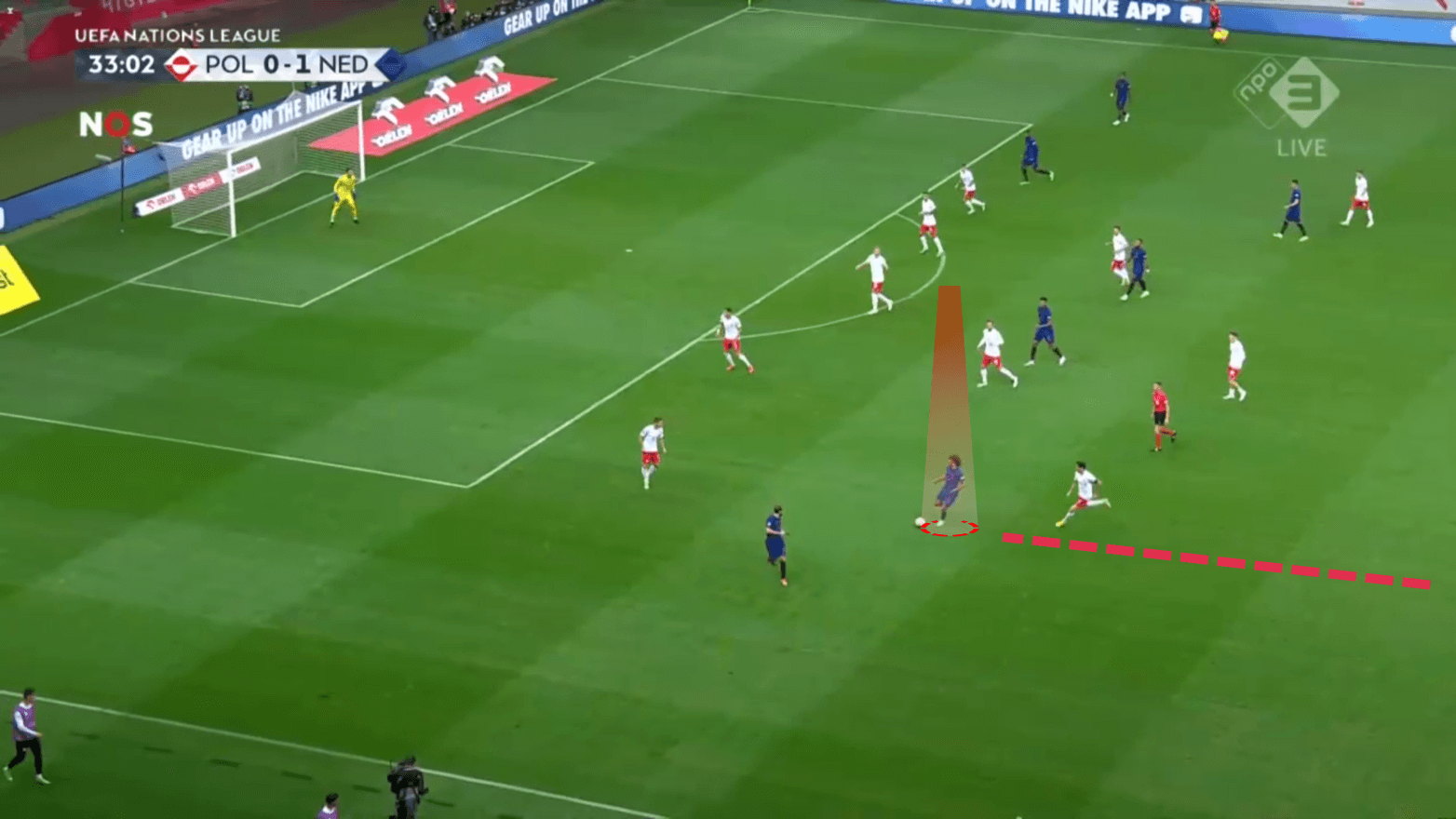
Louis van Gaal also likes to use his goalkeeper to create numerical overloads when teams press them very high up the pitch: Pasveer has been very good in these stages of the game, and he probably has earned a starting place at the World Cup because of this and his excellent reflexes.
The rotations are basically seen in every part of the pitch, Van Gaal likes versatile players that can solve situations in the wings, in the half-spaces, under pressure or in the central areas.
An example of what we are talking about is provided by Steven Berghuis and Cody Gakpo, who usually take the zones of their teammates to free them in other positions that rivals aren’t expecting. The latter likes to place himself hugging the line, to then drive to the middle and connect with players at the other side of the pitch.
Here we can see Gakpo taking Frenkie de Jong’s spot, as the Barcelona player joins the defensive line to open this space that the ‘10’ needs to get deep to help them beat the press.
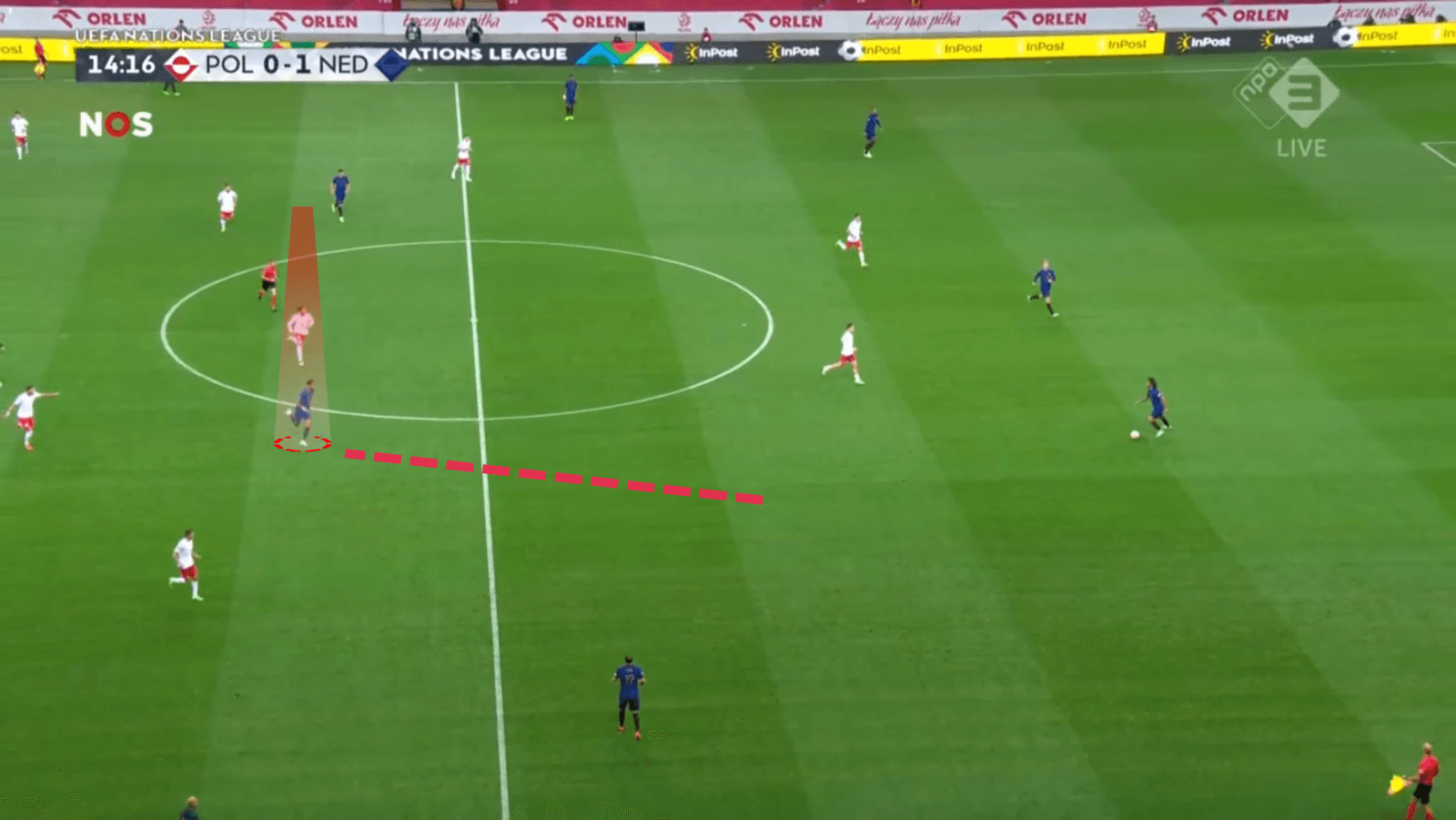
In the middle third of the pitch, the ‘Oranje’ try to be very fast and direct, as they look to dominate the game in the final third, so they have to accelerate possessions to play in the rival area during almost every part of the match. One of the movements the Netherlands apply to move along as a group, is the approach of Steven Bergwjin to the build-up first phase, where he can pick the ball, turn and find Cody Gakpo or Steven Berghuis to play short-combinations and arrive in the last third.
As well as in the first stages with the ball, they are also very mobile in these roles of who gets deep, where Gakpo and Berghuis exchange it frequently. Another set of off-the-ball movements is how Daley Blind likes to play inverted in the middle third if the ball is played in his side. If not, he then stays wide.
Here we see one of the trademark movements of the Netherlands, as Bergwjin drops off the striker’s lines to receive; he’s marked so he can’t turn and carry. As a result, he decides to play it to the man in front — this time, Aké, who then is going to see Vincent Janssen making the run thanks to the space Bergwjin has created behind him.
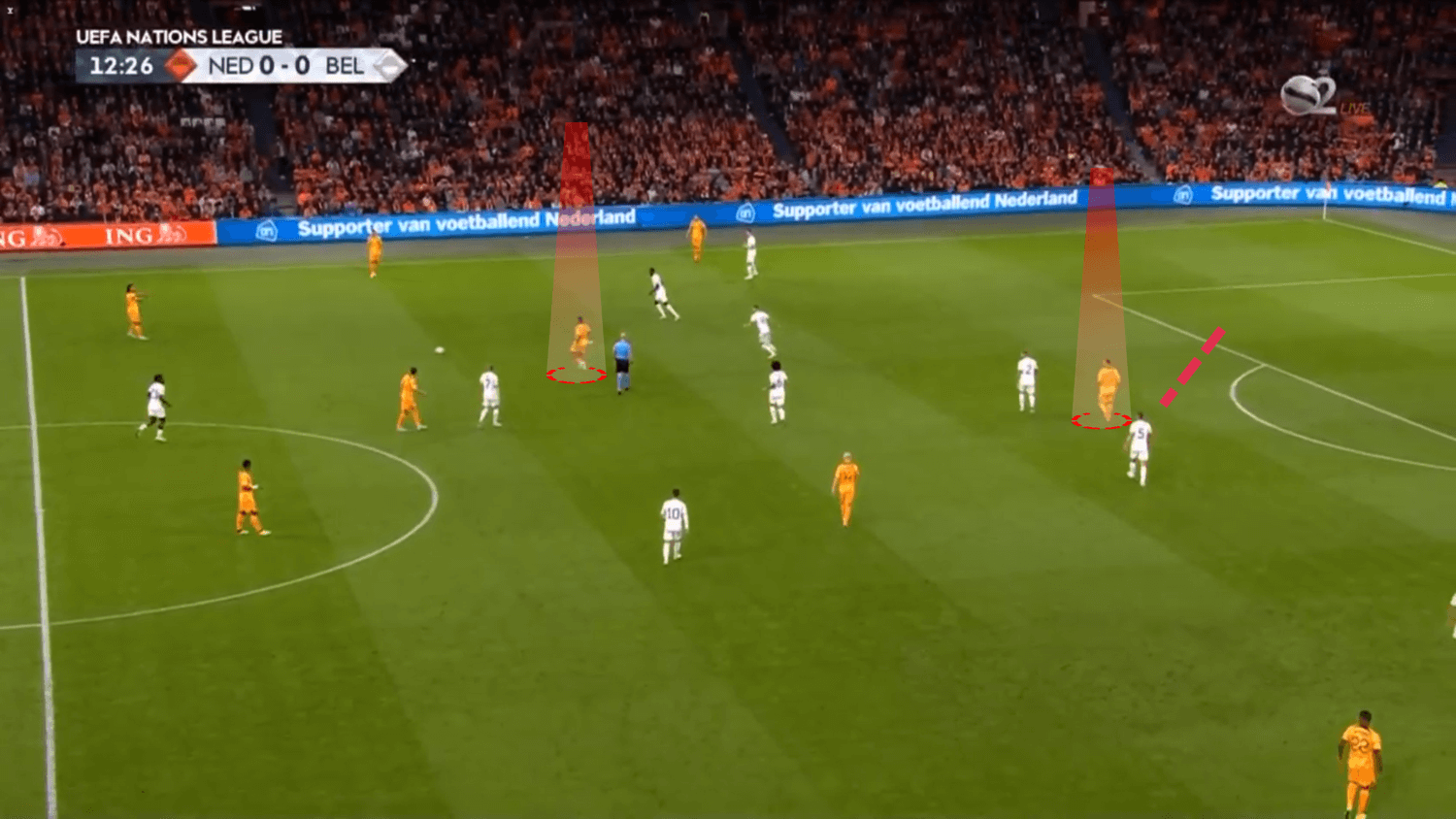
Van Gaal’s team have lacked that last-pass or last-touch inside the box to finish off the dominance they enjoy during matches. However, they’ve been trying to finish up the attacks with through-balls from outside the box to their mobile strikers who like to play sideways to the rival’s goal, to make these kinds of runs. Full-backs are taken into account too in attack, as they look to pin the last line of defenders or appear in wide areas with space, looking immediately for the other full-back on the weak side of the ball.
Two of these intentions are seen in the pictures below us. In the first one, we can see how Nathan Aké has once again joined the attack, practically as a midfielder. Depending on where the ball is, one of the centre-backs gets up like this. The idea is to attract players to jump, allowing one of the strikers to make a run in behind, as we see Janssen preparing to do.
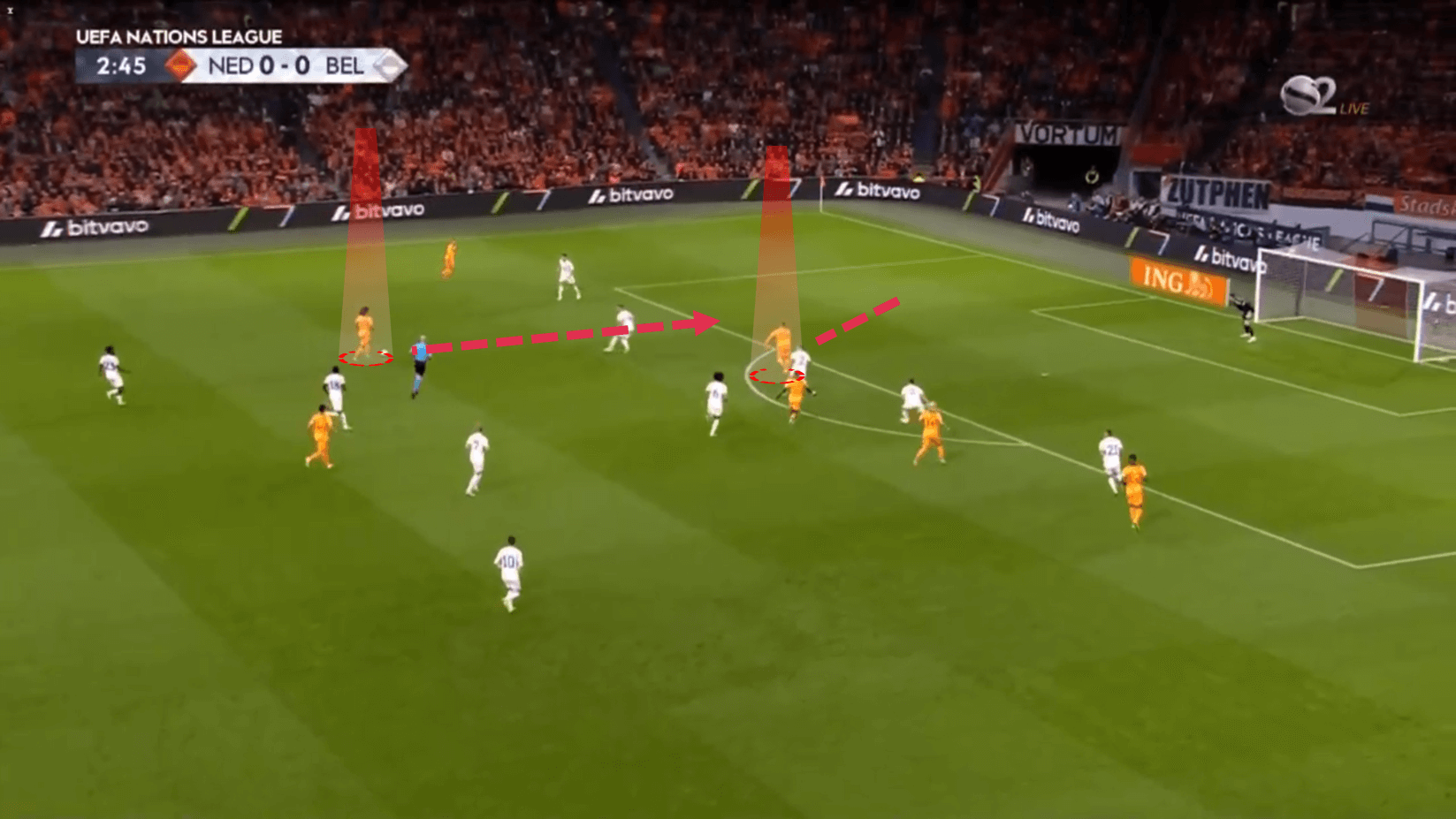
In the figure below, we see Steven Berghuis striking an out-swinging cross to find Daley Blind on the weak side of the ball. Blind is immediately attacking the space behind the marker to try and score a goal from that delivery.
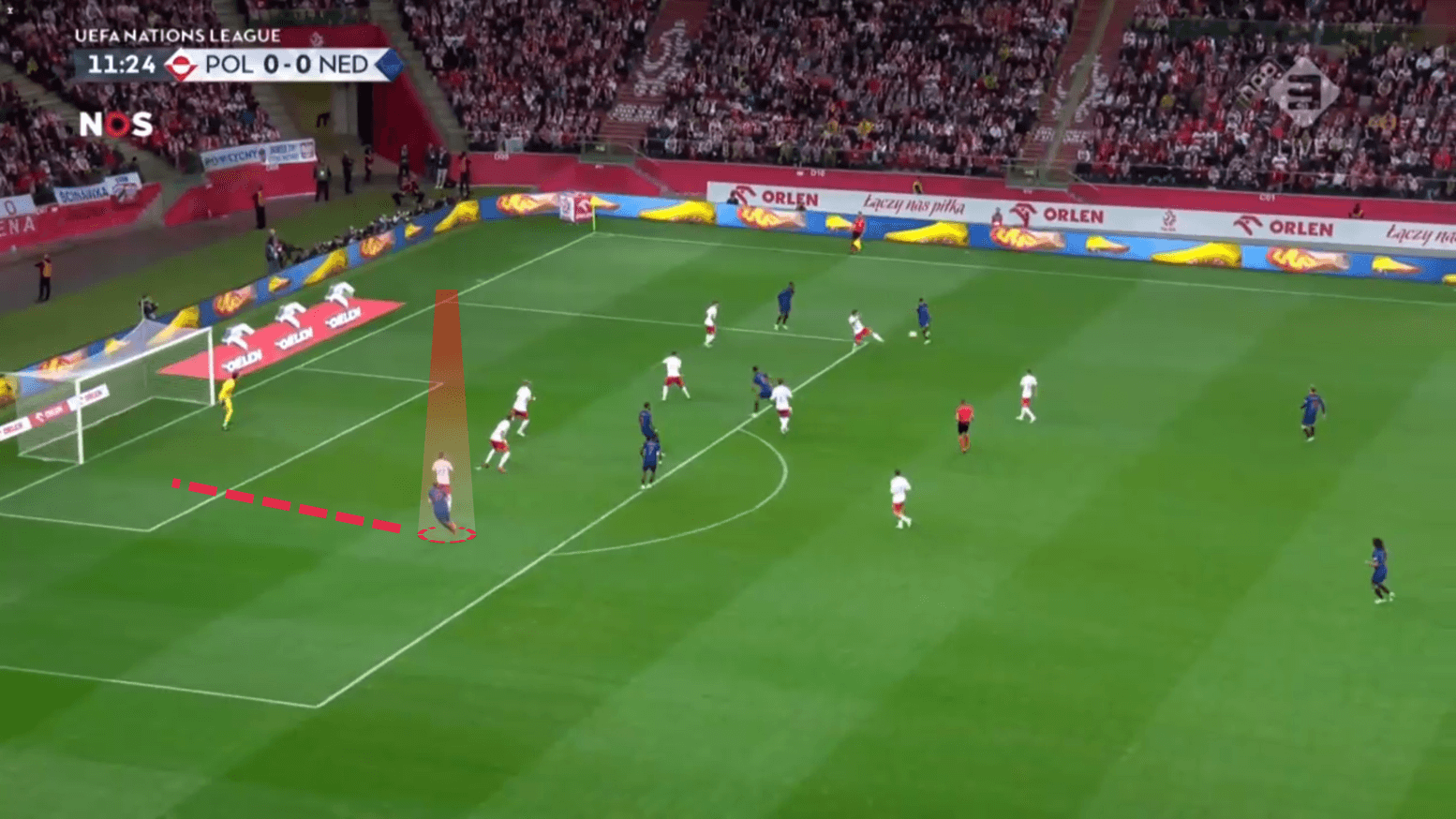
Defensive phase
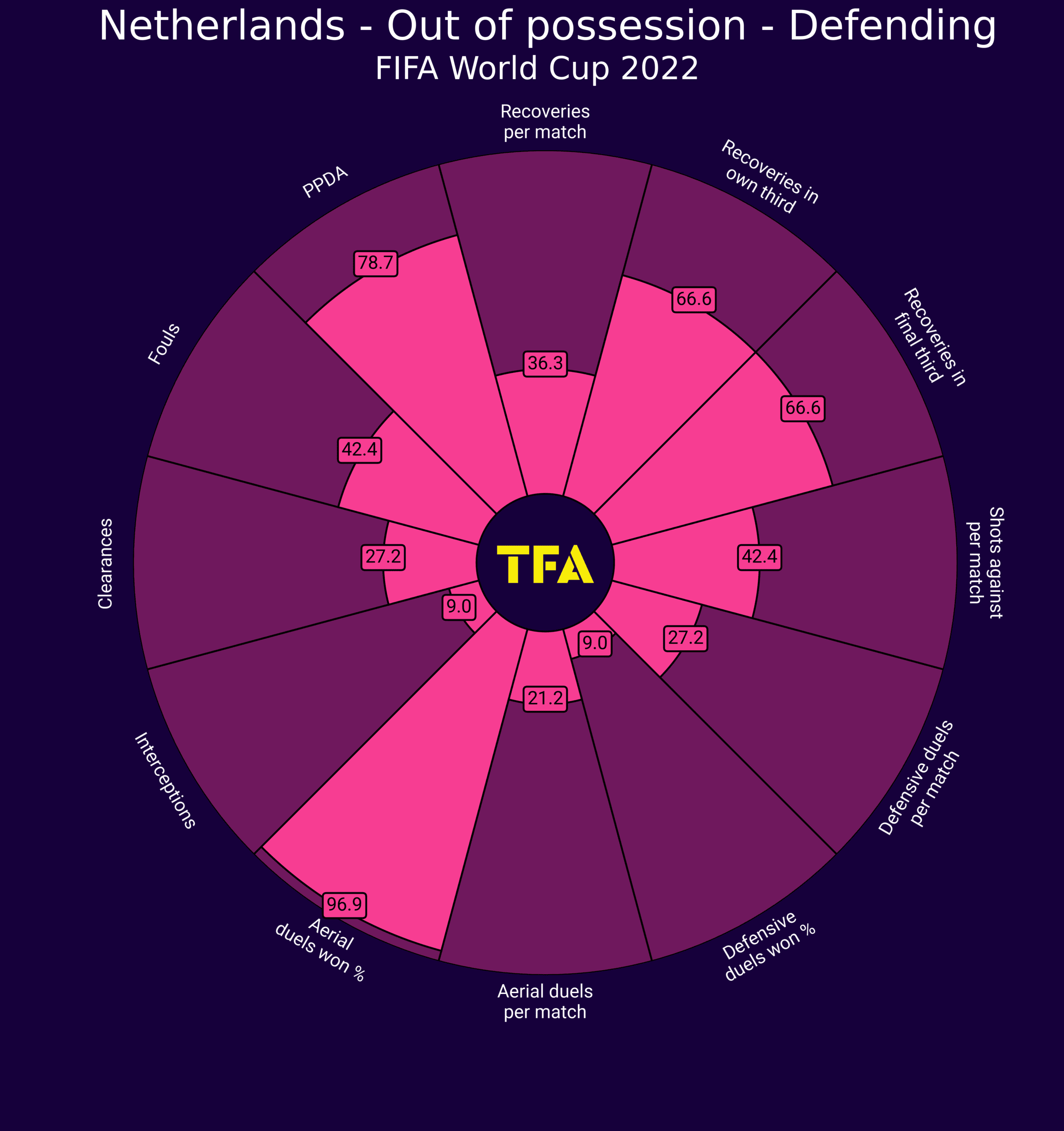
In the defensive phase of the game, Van Gaal likes to once again, use Jurrien Timber as his wildcard. Playing with Nathan Aké and Virgil Van Dijk at the back, or often Matthijs de Ligt too, Timber has the freedom to go off the line and be well-covered behind.
This is not just simple anticipation, the Ajax defender has a key role defending along the midfielders’ line, suffocating the free-man if a team likes to use a ‘10’ between the lines. He has the freedom to do it in different structures: Pressing high or closing down spaces when exchanging to a low-mid-block.
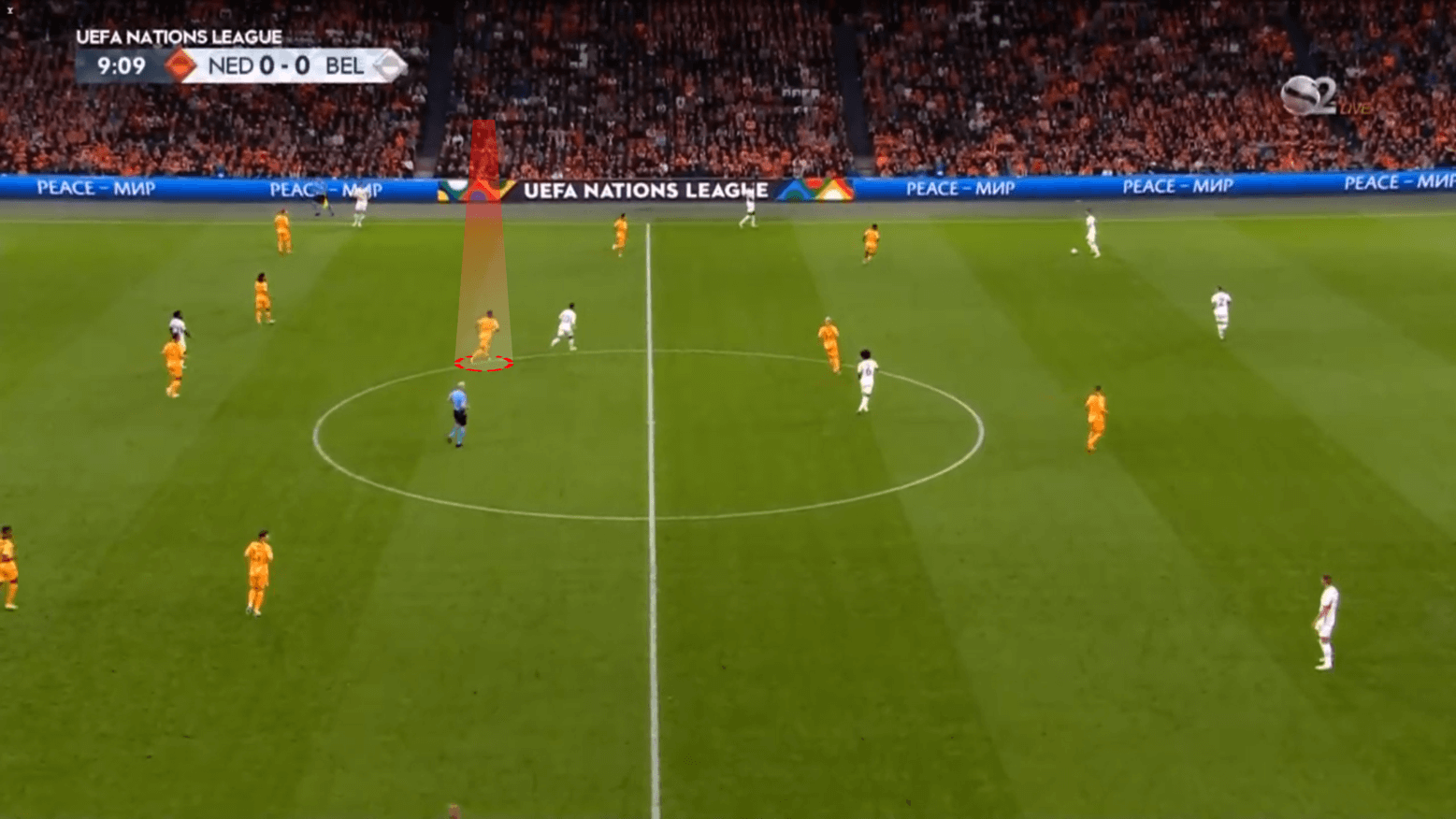
They set up a high-pressing idea with the two centre-forwards marking the centre-backs and the wing-backs going very high to mark rival full-backs. Cody Gakpo plays a pivotal role in shadowing the ‘6’ and jumping to the goalkeeper when this one receives. Behind the midfield line, Timber joins to defend the creative players, supported from behind by powerful defenders with solid anticipation, such as Van Dijk.
One of the biggest problems in the defensive phase where they have been very solid recently is the left-hand side of the team sitting in a low block. Daley Blind tends to make dangerous jumps that are often caught up by faster wingers than him, who then can run into the box. He is joined by Nathan Aké who has this type of issue too in his defending style, but what helps the team is the pace he can offer here, and Van Dijk’s cover too.
Transitions
In attacking transitions, the Netherlands like to give plenty of freedom for the player who just recovered the ball to carry for a while before releasing it close to the rival’s goal. These kinds of situations create plenty of chances throughout the game thanks to players like Gakpo who have great balance and composure when running with the ball, but you can also see variations with quick releases for a run in behind.
In defensive transitions, as told before, the ‘Clockwork Orange’ is a high-pressing team that likes to suffocate the opposition very close to their own box and make a man-marking press that would block every possible passing option. However, their rest-defence acts comfortably playing with a 3-2 or 2-3 if Timber joins the midfield where the excellent timing of Van Dijk is once again important for his team.
Defenders
Jasper Cillesen is one of the most known players of the team, beside his age and his decline at Barcelona, he has always been a vital part of the National Team, however as mentioned many times before, Remko Pasveer has taken his spot in recent games.
Centre-back is probably the position with the most depth in the Netherlands National Team, considering names like Virgil van Dijk, Matthijs de Ligt, Jurrien Timber, Nathan Aké and Stefan de Vrij; all of them with a great sense of passing and capability of defending in a high block. Full-backs are also decently covered with exciting names like Tyrell Malacia, Denzel Dumfries, Devyne Rensch or the experienced Daley Blind.
Midfielders
Another position in which the Dutch are well equipped is and has been for their entire history, the midfield. With names like Marten de Roon and Frenkie de Jong usually playing in the ‘6’ role, and more advanced midfielders such as Kenneth Taylor, Davy Klaasen, Steven Berghuis, or Ryan Gravenberch, their options are exciting. These promising and clever players suit Van Gaal’s ideas perfectly.
Attackers
The Netherlands’ attackers combine physical power with technical and elastic attributes. They boast different profiles such as Wout Weghorst or Memphis Depay, Vincent Janssen or Steven Bergwjin. Mixing excellent dribbling technique or capacities to play deep and turn to run to the goal, like Depay or Bergwjin, with lethal instinct inside the box or height to play as a target-man and drag defenders off their lines.
Key player
Besides having a large squad full of attacking talent, the Netherlands’ success depends on how Virgil van Dijk is going to perform defensively and adding worth to build-ups when he’s on the ball. We all know what van Dijk can do, at his best level he can be the best centre-back in the world. His timing in transitions has to be one of the toughest forwards have faced, and this could be one of the keys for Van Gaal’s team, as playing with a high block could be risky.
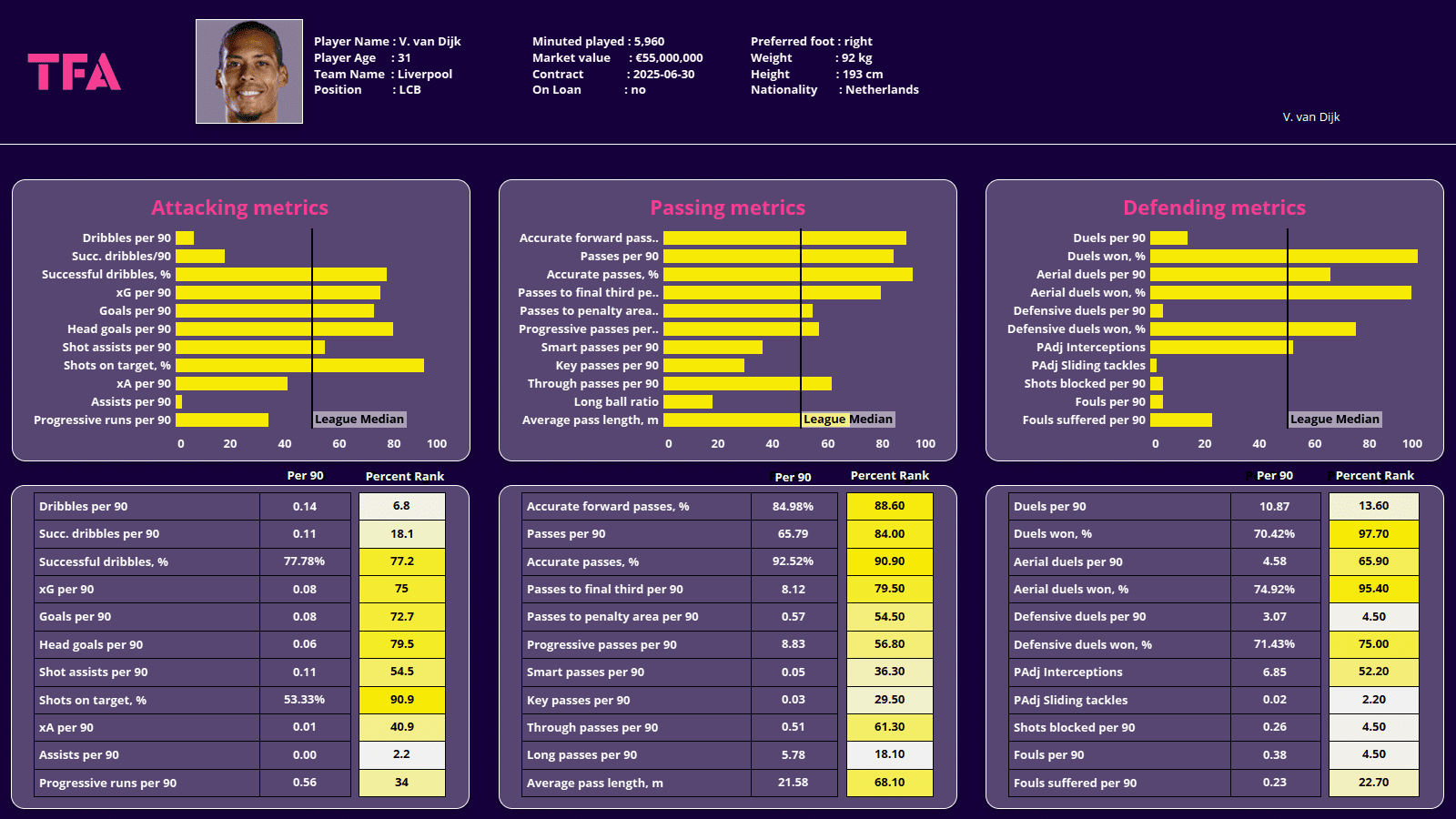
At 31 years of age, the Liverpool defender is about to play his first World Cup, which is his top-tournament debut for the Netherlands, as he was injured in the recent UEFA European Championship in 2021, and his country didn’t qualify for 2018 World Cup or 2016 European Championship. Therefore, it’s going to be a big step in his career.
Van Dijk and his input in every phase of the game is what makes him the best player in the team. The threat he brings while getting up for headers at set-pieces, his long distribution and also ability to break lines with passes or his amazing defending that brings solidity in the air and also a compact defensive line that is rarely being compromised all make him an elite defender.
Tournament prediction
This could be a massive year for the Netherlands considering the decline of several top European teams. With the arrival of Van Gaal as a coach, the ‘Oranje’ has immediately turned their status and are clearly a candidate to take the trophy home.

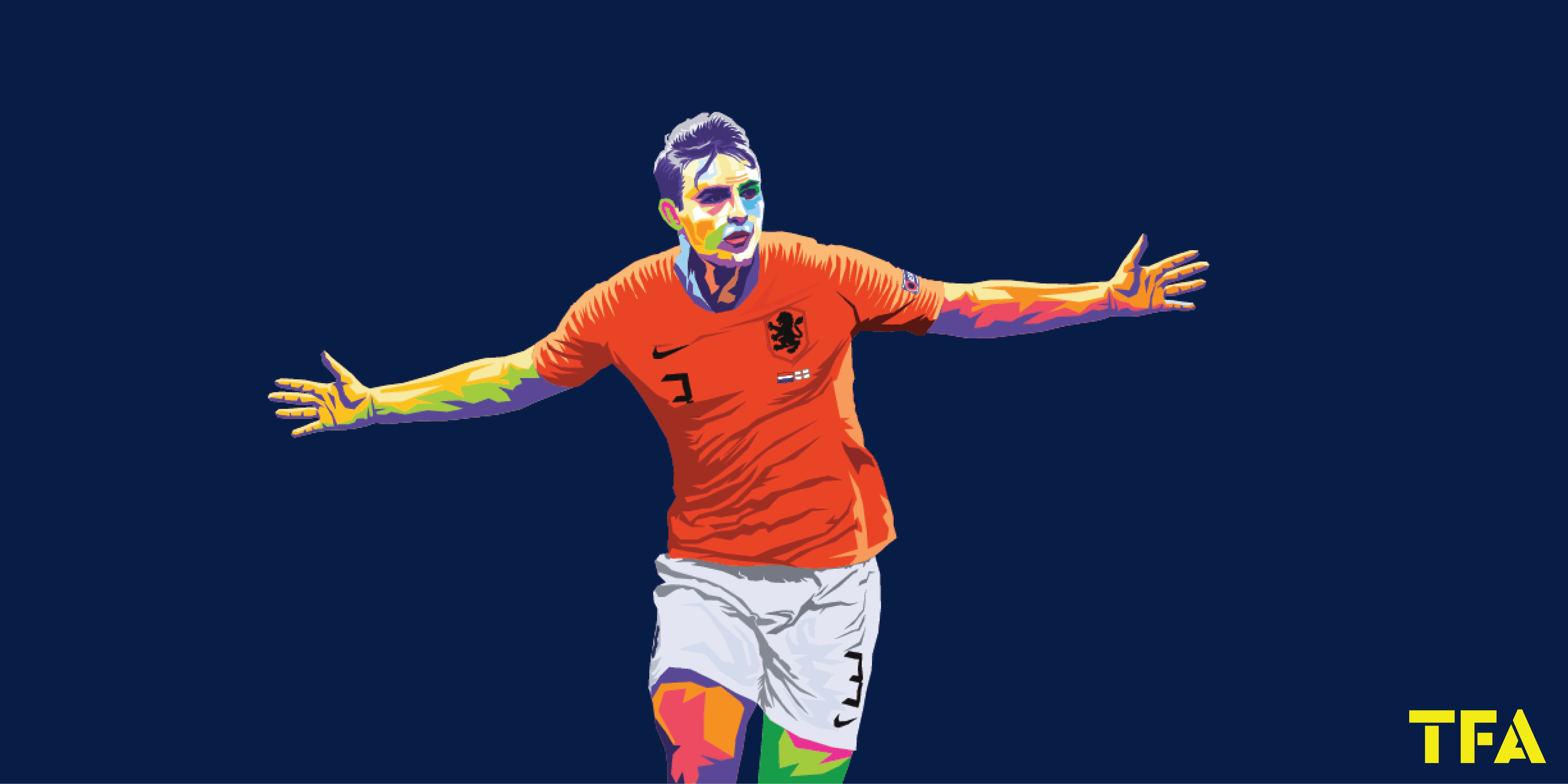




Comments